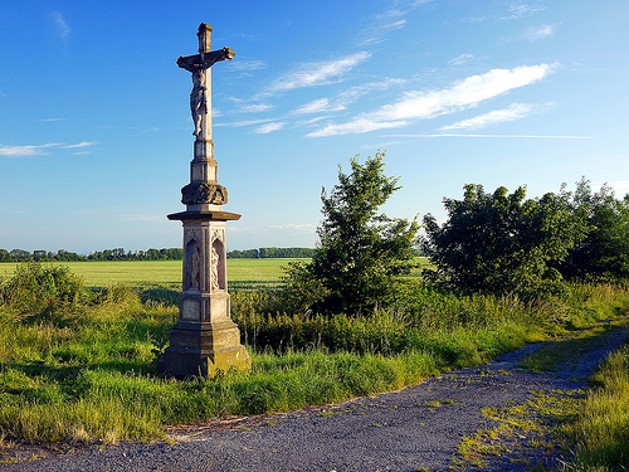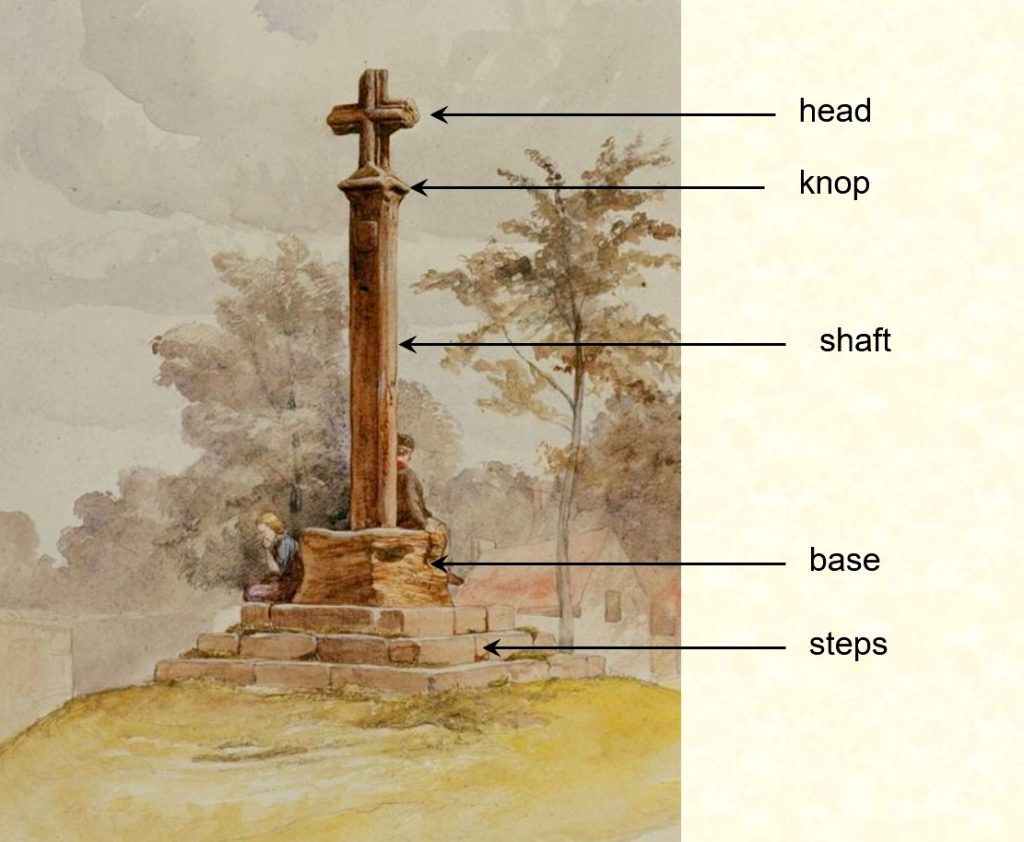What (and why) are Medieval Standing Crosses?
Standing crosses were a commonplace part of the English medieval landscape. We tend to think of them as stone structures, but that is just an aspect of survival as only stone crosses (or parts of stone crosses) survive into our century. Presumably a significant proportion of standing crosses were fashioned in timber although arguably those of stone may always have had higher status.

They are fundamentally religious symbols, however, in real life they had very practical purposes. Many were erected as stations for outdoor religious processions – notably on Palm Sunday, Rogationtide and the festival of Corpus Christi.

Roadside shrines are common in many parts of Catholic Europe and are similar in many ways to medieval standing crosses
Lincolnshire has the remains of over 180 later medieval stones crosses – now in varying stages of decline. As noted elsewhere on this website, the iconoclasts of the Reformation (16th C) and the English Civil War (17th C) systematically destroyed the symbols of the Roman Catholic church and any decorations or artefacts that could be deemed idolatrous. Standing crosses, as part of the paraphernalia of religious processions, were usually decapitated or demolished but those crosses which had a more secular function, such as market crosses, were often spared, even though they may have been part of the processional routes.
This website attempts to present information on, and photographs of, all the known crosses in Lincolnshire, within its gazetteer pages. You can move straight to the gazetteer HERE.
Admittedly, many are unremarkable, but if we were to pick the TOP TEN medieval crosses in Lincolnshire we might choose:
- Somersby churchyard cross
- Deeping St James village cross (lock-up)
- Silk Willoughby village cross
- Brinkhill churchyard cross
- Burwell – the Buttermarket
- Crowland St Guthlac’s stone
- Sutton St James village cross
- Spilsby market cross
- Tattershall market cross
Many medieval standing crosses are found in churchyards but are often later in date than the church itself, negating any suggestion that the cross is an early meeting point for worship and preaching. Churchyard crosses are probably part of the processional cycle although there is also a clear case for some being retro-fitted into churchyards from other parts of the village as lifestyle and streetscape changed with time.
Crosses were often erected in the communal areas of a town or village – the village green or town square – which usually served also as market place and a gathering place for proclamations and public meetings. A market cross (sometimes termed a Butter Cross) was a symbol of fair and honest trade (carried out under the eyes of God) and the structures themselves evolved from simple standing crosses set on steps to quite elaborate buildings surmounted by the cross, validating the transactions being carried on beneath. The authority of the Market Cross extended to it being the right and proper place for the proclamation of important news and statements and thus the site of the cross becomes the focus of not only religious significance, but of civil solemnity and status.
Almost all the standing crosses in the UK were defaced, decapitated or destroyed at the reformation or in the Civil War. The cross heads (in all their varieties) have mostly been smashed, leaving at best a section of shaft still set in its base mounting or at worst a lonely, displaced socket stone. They are thus, one of the least valued and understood monuments of the later medieval period.
The cross remains described in this website are mostly thought to be twelfth to sixteenth century in origin – The remains of some forty ‘Saxon’ crosses are known within the county and it is not proposed to describe these in detail, for that has already been admirably done in The Corpus of Anglo-Saxon Stone Sculpture – Lincolnshire (Vol 5) by Paul Everson and David Stocker. See: https://chacklepie.com/ascorpus/catvol5.php
The Anatomy of a Medieval Cross

CROSS HEADS : because these were the main target of 16th and 17th century iconoclasts, few have survived. A very wide range of designs were employed. Replacement heads are often found.
KNOP : The terminal of the shaft and usually integral with it. Often simple, occasionally elaborate. As with cross heads, they rarely survive.
SHAFT : Usually square or octagonal. Generally a single piece of stone – but many survivors are repaired.
BASE or SOCKET STONE: (occasionally called a ‘socle’)- Usually square with a central square socket for the cross shaft. The corners are often decorated – on notable examples, the side faces are carved.
STEPS : Some crosses are mounted on two or three steps – others have none (just a socket stone). Market crosses may have many steps, and thus have a very broad base
- Addlethorpe
- Aisthorpe
- Alford
- Alkborough
- Allington
- Alvingham
- Ancaster
- Anderby
- Anwick
- Appleby
- Aunsby
- Bag Enderby
- Bardney
- Barrow on Humber
- Barrowby
- Barton upon Humber
- Beckingham
- Belleau
- Benniworth
- Bilsby
- Binbrook
- Blyton
- Boston
- Bottesford
- Bourne
- Braceborough
- Bradley
- Brant Broughton
- Brigsley
- Brinkhill
- Bucknall
- Burwell
- Butterwick
- Byard’s Leap
- Carlby
- Castle Carlton
- Caythorpe
- Claypole
- Clixby
- Coningsby
- Corby Glen
- Cranwell
- Crowland – Kenulph’s Cross
- Crowland – Overview
- Crowland – St Guthlac’s Cross
- Crowland – St Vincent’s Cross
- Crowland – Triangular Bridge
- Crowle
- Deeping St James
- Denton
- Digby
- Dorrington
- Dunsby
- Easton
- Edenham
- Epworth
- Ewerby
- Farlesthorpe
- Firsby
- Folkingham
- Fosdyke
- Freiston
- Friesthorpe
- Friskney
- Fulbeck
- Fulstow
- Gedney Hill
- Gelston
- Grantham (Apple Cross)
- Grantham (Market Cross)
- Grayingham
- Great Steeping
- Grimoldby
- Grimsby
- Gunby
- Haltham
- Harlaxton
- Haxey (1) The Buttercross
- Haxey (2) Mowbray Stone
- Haxey (3) Greenhill Cross
- Healing